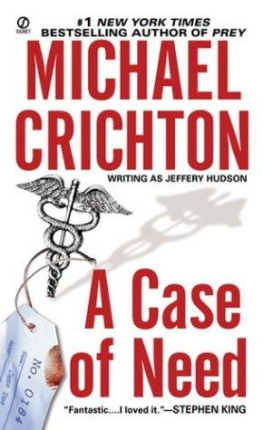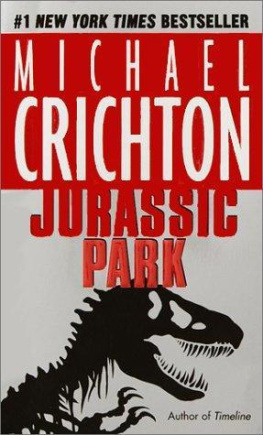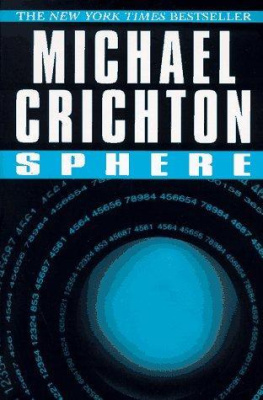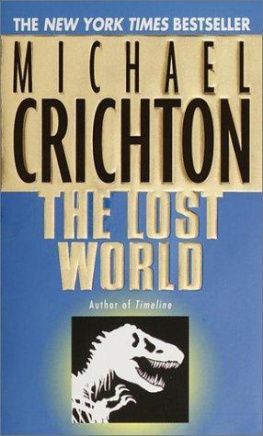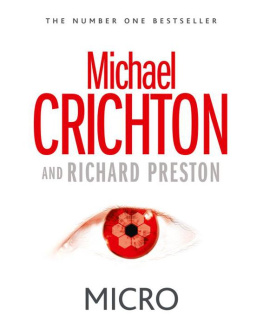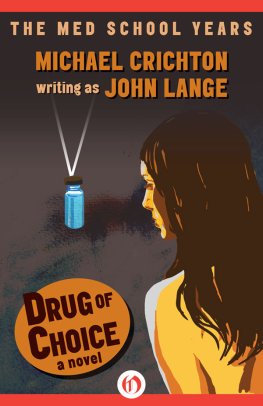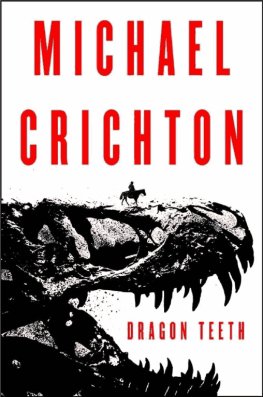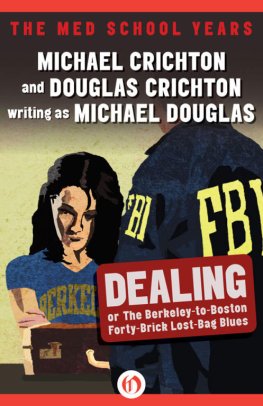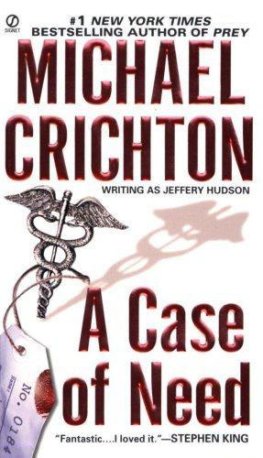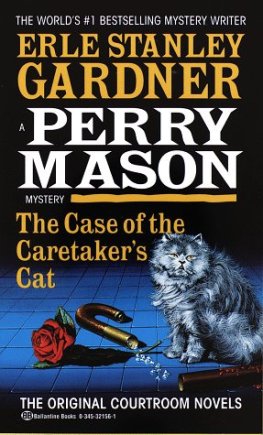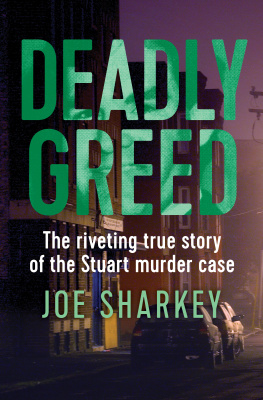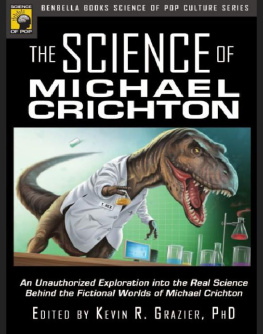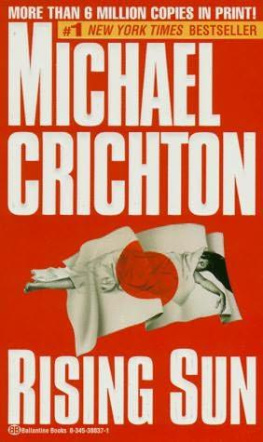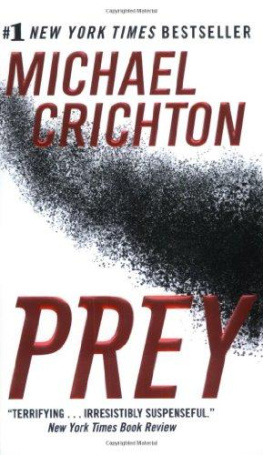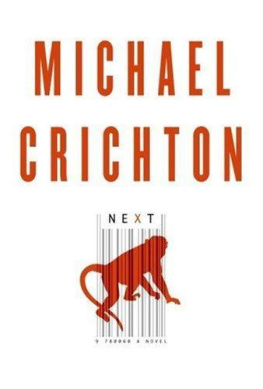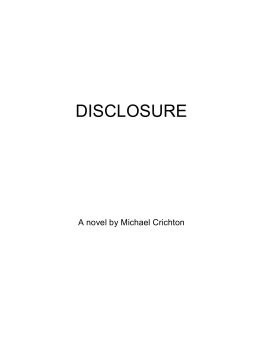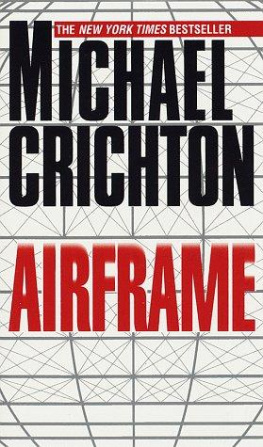Michael Crichton - Case of Need
Here you can read online Michael Crichton - Case of Need full text of the book (entire story) in english for free. Download pdf and epub, get meaning, cover and reviews about this ebook. year: 2003, publisher: Tandem Library, genre: Detective and thriller. Description of the work, (preface) as well as reviews are available. Best literature library LitArk.com created for fans of good reading and offers a wide selection of genres:
Romance novel
Science fiction
Adventure
Detective
Science
History
Home and family
Prose
Art
Politics
Computer
Non-fiction
Religion
Business
Children
Humor
Choose a favorite category and find really read worthwhile books. Enjoy immersion in the world of imagination, feel the emotions of the characters or learn something new for yourself, make an fascinating discovery.
- Book:Case of Need
- Author:
- Publisher:Tandem Library
- Genre:
- Year:2003
- Rating:5 / 5
- Favourites:Add to favourites
- Your mark:
- 100
- 1
- 2
- 3
- 4
- 5
Case of Need: summary, description and annotation
We offer to read an annotation, description, summary or preface (depends on what the author of the book "Case of Need" wrote himself). If you haven't found the necessary information about the book — write in the comments, we will try to find it.
Case of Need — read online for free the complete book (whole text) full work
Below is the text of the book, divided by pages. System saving the place of the last page read, allows you to conveniently read the book "Case of Need" online for free, without having to search again every time where you left off. Put a bookmark, and you can go to the page where you finished reading at any time.
Font size:
Interval:
Bookmark:
ISBN: 1-4176-3716-1
ISBN: 978-1-4176-3716-4
Publisher: Turtleback Books:
A Division of Sanval
* * * * *
I will prescribe regimen for the good of my pa-tients, according to my judgment and ability, andnever do harm to anyone. To please no one will Iprescribe a deadly drug, nor give advice which maycause his death. Nor will I give a woman a pessaryto procure abortion. But I will preserve the purity of my life and my art....-FROM THE HIPPOCRATIC OATHDEMANDED OF THE YOUNG PHYSICIANABOUT TO
ENTER UPON THE PRACTICEOF HIS PROFESSION.
There is no moral obligation to conserve DNA.
Garrett Hardin
MONDAY
OCTOBER 10
ONE
ALL HEART SURGEONS ARE BASTARDS, and Conway is
no exception. He came storming into the path labat 8:30 in the morning, still wearing his green sur-gical gown and cap, and he was furious. WhenConway is mad he clenches his teeth and speaksthrough them in a flat monotone. His face turns red, with purple blotches at the temples.
"Morons," Conway hissed, "goddamned morons."He pounded the wall with his fist; bottles in the cabinets rattled.
We all knew what was happening. Conway doestwo open-heart procedures a day, beginning the firstat 6:30. When he shows up in the path lab twohours later, there's only one reason.
"Stupid clumsy bastard," Conway said. He kickedover a wastebasket. It rolled noisily across the floor.
"Beat his brains in, his goddamned brains,"Conway said, grimacing and staring up at the ceil-ing as if addressing God. God, like the rest of us,
had heard it before. The same anger, the sameclenched teeth and pounding and profanity.Conway always ran true to form, like the rerun of
a movie.
Sometimes his anger was directed against thethoracic man, sometimes against the nurses, some-times against the pump technicians. But oddlyenough, never against Conway.
"If I live to be a hundred," Conway hissedthrough his teeth, "I'll never find a decent anesman. Never.
They don't exist. Stupid, shit-eatingbastards, all of them."
We glanced at each other: this time it wasHerbie. About four times a year the blame fell onHerbie. The rest of the time he and Conway weregood friends. Conway would praise him to the sky,call him the finest anesthesiologist in the country,better than Sonderick at the Brigham, better thanLewis at the Mayo, better than anyone.
But four times a year, Herbert Landsman was re-sponsible for a DOT, the surgical slang for a deathon the table. In cardiac surgery, it happened a lot:fifteen percent for most surgeons, eight percent fora man like Conway.
Because Frank Conway was good, because hewas an eight-percenter, a man with lucky hands, a man with the touch, everyone put up with his tem-per tantrums, his moments of anger and destruc-tiveness.
Once he kicked over a path microscopeand did a hundred dollars' worth of damage. Nobody blinked, because Conway was an eight-percenter.
Of course, there was scuttlebutt in Boston abouthow he kept his percentage, known privately among surgeons as the "Kill rate," down. They saidConway avoided cases with complications. Theysaid Conway avoided jerry cases.1They saidConway never innovated, never tried a new anddangerous procedure. The arguments were, ofcourse, wholly untrue. Conway kept his kill ratelow because he was a superb surgeon. It was as simple as that.
The fact that he was also a miserable person wasconsidered superfluous.
"Stupid, stinking bastard," Conway said. Helooked angrily about the room. "Who's on today?"
"I am," I said. I was the senior pathology staffmember in charge for the day. Everything had to becleared through me. "You want a table?"
"Yeah. Shit."
"When?"
"Tonight."
It was a habit of Conway's. He always did hisautopsies on the dead cases in the evening, oftengoing long into the night. It was as if he wanted topunish himself. He never allowed anyone, not evenhis residents, to be present. Some said he criedwhile he did them. Others said he giggled. The factwas that nobody really knew. Except Conway.
' Geriatrics.
"I'll tell the desk," I said. "They'll hold a lockerfor you."
"Yeah. Shit." He pounded the table. "Mother offour, that's what she was."
"I'll tell the desk to arrange everything." "Arrested before we got into the ventricle. Cold. We massaged for thirty-five minutes, but nothing.Nothing."
"What's the name?" I said. The desk would needthe name.
"McPherson," Conway said, "Mrs. McPherson."He turned to go and paused by the door. Heseemed to falter, his body sagging, his shouldersslumping.
"Jesus," he said, "a mother of four. What the hellam I going to tell him?"
He held his hands up, surgeon-style, palms fac-ing him, and stared at his fingers accusingly, as ifthey had betrayed him. I suppose in a sense theyhad.
"Jesus," Conway said. "I should have been a der-matologist. Nobody ever dies on a dermatologist."
Then he kicked the door open and left the lab.
when we were alone,one of the first-year resi-dents, looking very pale, said to me, "Is he alwayslike that?"
"Yes," I said. "Always."
I turned away, looking out at the rush-hour traffic moving slowly through the October drizzle. It would have been easier to feel sympathy for Conway if I
didn't know that his act was purely for himself, a kindof ritual angry deceleration that he went through ev-ery time he lost a patient. I guess he needed it, butstill most of us in the lab wished he could be like Delong in Dallas, who did crossword puzzles inFrench, or Archer in Chicago, who went out and hada haircut whenever he lost someone.
Not only did Conway disrupt the lab, he put usbehind. In the mornings, that was particularly bad, because we had to do the surgical specimens andwe were usually behind schedule anyway.
I turned my back to the window and picked upthe next specimen. We have a high-speed tech-nique in the lab: the pathologists stand beforewaist-high benches and examine the biopsies. A mi-crophone hangs from the ceiling before each of us,and it's controlled by a foot pedal. This leaves yourhands free; whenever you have something to say, you step on the pedal and speak into the mike, re-cording your comments on tape. The secretaries type it up later for the charts.2
I've been trying to stop smoking for the pastweek, and this specimen helped me: it was a white lump imbedded in a slice of lung. The pink tag at-tached gave the name of the patient; he was down in the OR
now with his chest cut open. The sur-geons were waiting for the path dx3before proceed-2The files containing the history of treatment of patients in the hospital.
Called a "chart" because the bulk of the file consists of daily charts of temperature, blood pressure, pulse and respiration, the so-called "vital signs."
3 Diagnosis.
ing further with the operation. If this was a benign tumor, they'd simply remove one lobe of his lung. If it was malignant, they'd take the whole lung and allhis lymph nodes.
1 stepped on the floor pedal."Patient AOfour-five-two-three-three-six. Jo-seph Magnuson, The specimen is a section of rightlung, upper lobe, measuring"I took my foot off the pedal and measured it"five centimeters byseven point five centimeters. The lung tissue is pale pink in color and crepitant.4The pleural surface issmooth and glistening, with no evidence of fibrous material or adhesions.
There is some hemorrhage.Within the parenchyma is an irregular mass, white in color, measuring"
I measured the lump"approximately two centi-meters in diameter. On cut surface, it appears whit-ish and hard. There is no apparent fibrous capsule,and there is some distortion of surrounding tissue structure. Gross impression... cancer of the lung,suggestive of malignancy, question mark metastatic.
Font size:
Interval:
Bookmark:
Similar books «Case of Need»
Look at similar books to Case of Need. We have selected literature similar in name and meaning in the hope of providing readers with more options to find new, interesting, not yet read works.
Discussion, reviews of the book Case of Need and just readers' own opinions. Leave your comments, write what you think about the work, its meaning or the main characters. Specify what exactly you liked and what you didn't like, and why you think so.

